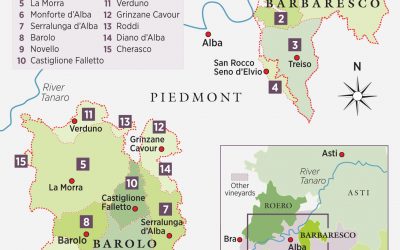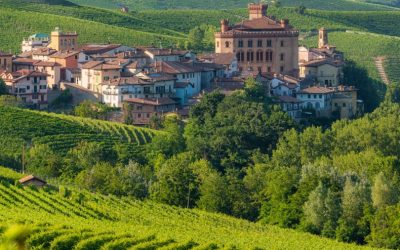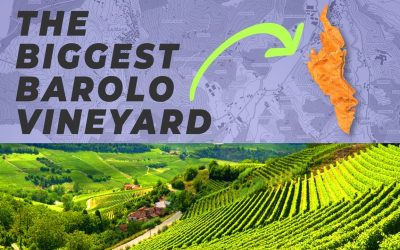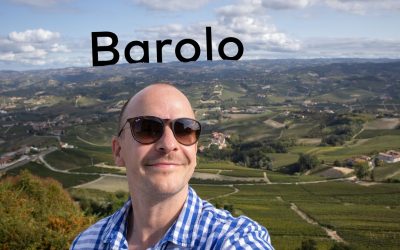Is Barolo like Cabernet Sauvignon? Main differences
In the world of fine wines, both Barolo and Cabernet Sauvignon hold prestigious positions. Barolo, the “king of wines,” hails from the foggy hills of Piedmont, Italy, while Cabernet Sauvignon, one of the world’s most recognized red wine grape varieties, has its origins in the vineyards of Bordeaux, France but is now grown globally. Despite their shared full-bodied nature and profound complexity, these two wines have distinctive characteristics influenced by grape variety, terroir, winemaking practices, and more.
Is Barolo like Cabernet Sauvignon?
While Barolo and Cabernet Sauvignon are both red wines, they have distinctive characteristics due to their different grape varieties and terroirs. Barolo is made from Nebbiolo grapes in the Piedmont region of Italy. This wine is famous for its high tannins and acidity, along with a complex bouquet of aromas including cherry, rose, licorice, and truffles. When aged, Barolo develops further complex flavors of leather, tar, and dried fruit. Discover more about what is Barolo.
Cabernet Sauvignon, on the other hand, is a globally planted grape varietal known for its full body, high tannins, and moderate acidity. It typically exhibits flavors of dark fruits like blackcurrant, plum, and cherry, along with notes of cedar, vanilla, tobacco, and sometimes green bell pepper, especially when aged in oak. Both wines have significant aging potential and are known for their robustness and complexity. However, the similarities somewhat end there. A Barolo wine is typically more ethereal, lighter in body and color, and has a more delicate fruit profile than a Cabernet Sauvignon.
Therefore, while Barolo and Cabernet Sauvignon share a few broad similarities (like high tannins and the ability to age), they are quite distinct wines, each with their unique qualities and expressions.
Why is Barolo so expensive?
Barolo, often referred to as the “king of wines and wine of kings,” is considered one of Italy’s finest wines and is typically more expensive than many other wines due to several factors:
- Limited Production: Barolo is made from the Nebbiolo grape, which is primarily grown in a small region of Piedmont in Northwest Italy. The region’s severe weather conditions and unique terroir mean that only a limited quantity of Nebbiolo grapes can be produced each year, restricting the production of Barolo wine.
- Long Aging Process: By law, Barolo wines must be aged for a minimum of 38 months after the harvest, with at least 18 months in wooden barrels. This extended aging process not only ties up capital for a long period but also requires extensive storage space, contributing to the wine’s high cost.
- High Quality: Barolo wines are known for their exceptional quality. They are rich, full-bodied wines with complex aromas and flavors, often requiring years of bottle aging to reach their full potential. This high level of quality and reputation justifies the higher price point.
- Demand and Prestige: The prestigious reputation of Barolo wine, combined with limited production, creates a high demand that can outpace supply, further driving up the price.
- Strict Regulations: The production of Barolo is tightly controlled by the Italian wine regulatory body, the Denominazione di Origine Controllata e Garantita (DOCG). These regulations ensure that Barolo maintains its high standard, but they also limit the amount that can be produced, again contributing to the higher price.
- Labor-Intensive: The Nebbiolo grape is notoriously difficult to grow and harvest, requiring a great deal of care and manual labor. This increases the cost of production, which is passed on to the consumer in the form of higher prices.
Overall, the expense of Barolo reflects the time, labor, and care that goes into producing this highly valued wine.
What does Barolo taste like?

Main differences between Barolo an Cabernet Sauvignon
The main differences between Barolo and Cabernet Sauvignon are in their flavor profiles, aging potential, and region of production. Here are the key contrasts:
- Grape Varieties: Barolo is made from 100% Nebbiolo grapes grown in the Piedmont region of Italy. Cabernet Sauvignon is a grape variety that’s grown worldwide, with prominent examples hailing from Bordeaux in France and Napa Valley in California.
- Flavor Profile: Barolo is known for its high tannins and acidity, with flavors of cherry, rose, licorice, and truffles. As it ages, it can develop further complex flavors like tar, leather, and dried fruits. Cabernet Sauvignon, on the other hand, is characterized by its full body, high tannins, and flavors of dark fruits like blackcurrant and plum. It can also exhibit notes of vanilla, tobacco, and green bell pepper, especially when aged in oak.
- Aging Potential: Both wines have high aging potential due to their robust tannic structure. However, Barolos often require longer to soften and reach their peak, while Cabernet Sauvignons can be more approachable earlier on.
- Climatic Preferences: Nebbiolo for Barolo thrives in a cooler, continental climate and calcareous soils of Piedmont. Cabernet Sauvignon, however, is highly adaptable and can be grown in a variety of climates, though it prefers warmer climates and well-draining soils.
In summary, while both wines are considered high-quality, robust reds with significant aging potential, their flavors, grape variety, and terroir are distinctly different, offering unique experiences to wine enthusiasts.
Winemaking Traditions: Barolo vs Cabernet Sauvignon
While the winemaking process for both Barolo and Cabernet Sauvignon involves fermentation and aging, the traditions and methods can differ. In making Barolo, the fermentation process is long, often extending over several weeks, to extract maximum flavor and tannins from the Nebbiolo skins. The wine is then aged for at least 38 months, 18 of which in wooden barrels. On the contrary, Cabernet Sauvignon doesn’t require as long a fermentation period, and aging durations can vary based on the winemaker’s preference and the desired wine style.
Popularity and Accessibility: Barolo vs Cabernet Sauvignon
Cabernet Sauvignon, being more widely grown and recognized globally, is generally more accessible than Barolo. Its robust and consistent flavor profile, along with its ability to grow in various climates, has made it a favorite among wine lovers worldwide. Barolo, while acclaimed in the wine world, is more of a specialty wine due to its limited production in the specific communes of Piedmont, Italy. It is highly sought after by collectors and enthusiasts for its complex flavors and excellent aging potential.
Food Pairings: Barolo vs Cabernet Sauvignon
Due to their full-bodied and tannic nature, both Barolo and Cabernet Sauvignon pair well with rich, meaty dishes. However, the high acidity of Barolo makes it a perfect companion to dishes with a good amount of fat or umami flavors, such as truffles, aged cheeses, and game meats. Cabernet Sauvignon, with its dark fruit and often oak-influenced flavors, pairs excellently with grilled or roasted red meats, lamb, and strong cheeses. It’s also a great match for dishes with a hint of sweetness, which complements its fruit-forward profile.
By understanding these differences, wine enthusiasts can fully appreciate the unique attributes of both Barolo and Cabernet Sauvignon, and select the right bottle for the right occasion or food pairing.
Conclusion: Savoring the Unique Charm of Barolo and Cabernet Sauvignon
To wrap up, Barolo and Cabernet Sauvignon, though both high-quality red wines, offer different experiences for wine enthusiasts. Barolo, made exclusively from Nebbiolo grapes, stands out for its high tannin and acidity levels, long aging potential, and compatibility with rich, savory dishes. On the other hand, Cabernet Sauvignon, known for its robust and consistent flavor, offers versatility in pairing and greater global accessibility. Whether you’re drawn to the ethereal allure of Barolo or the universally beloved profile of Cabernet Sauvignon, exploring these differences promises a fascinating journey into the depths of wine appreciation.




